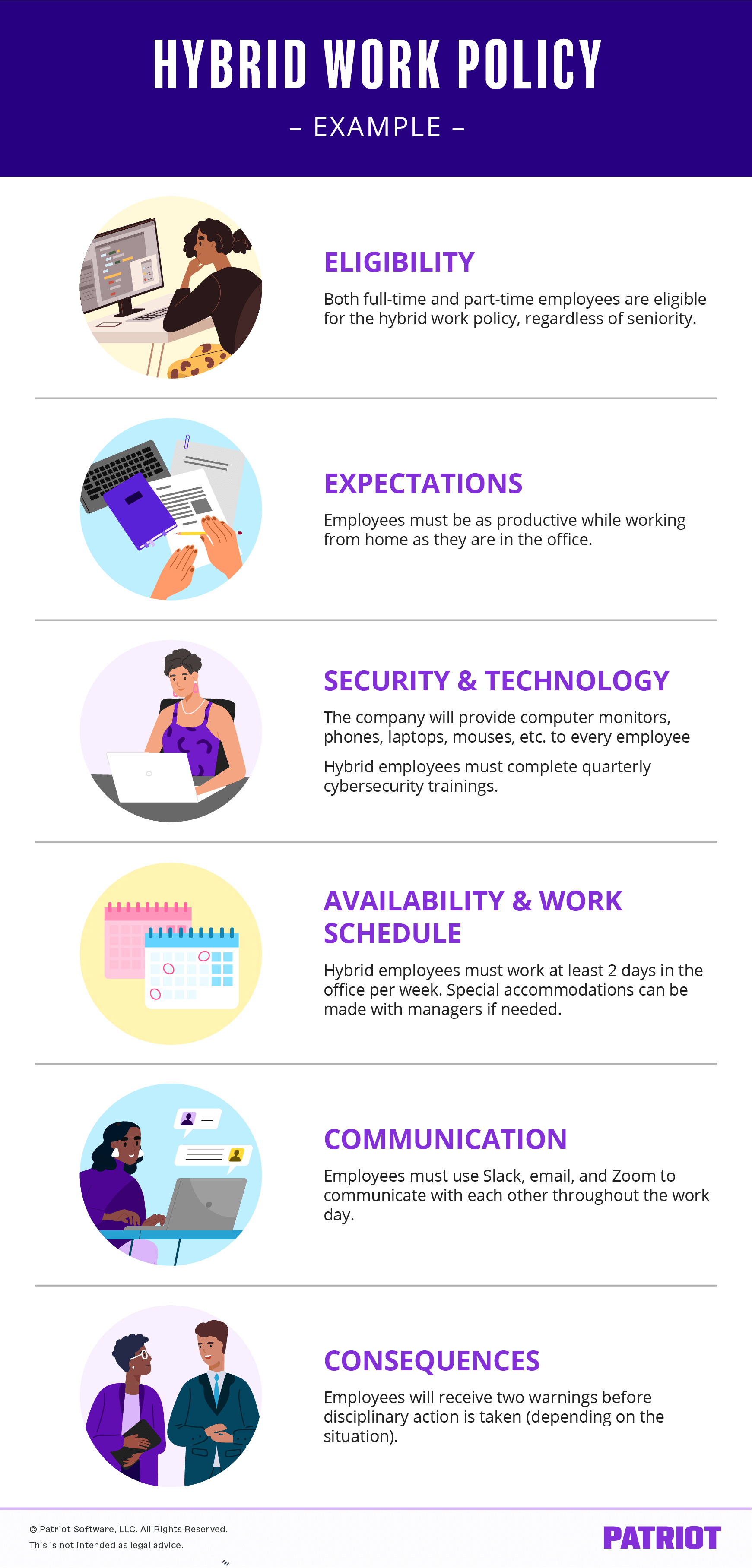Thanks to the pandemic, there’s a new sheriff in town: Hybrid workplaces. In fact, 74% of companies in the U.S. are using or plan to implement a permanent hybrid work model. If your company plans to be part of this statistic, you need to know what to include in a hybrid work policy to keep your team on the same page.
What is a hybrid work policy?
A hybrid workplace is a mixture of in-office and remote work. If you’re considering a hybrid workplace for your business or already have one, you may want to implement a hybrid work policy and add it to your employee handbook. But, what is a hybrid work policy exactly? This type of policy outlines the guidelines employees need to follow whether they’re working from home or in-person.
What’s the point of a hybrid work model policy? Your policy lays all of your expectations out for your team. It lets your employees know what you expect of them and what policies are in place for hybrid work.
Hybrid work schedule policy: 6 Sections to include
Hybrid policies can vary from business to business. Simply put, there is no universal policy that works well for every company. It may take some trial and error to get your policy just right for your business—and that’s OK!
So, what kinds of things should you include in your policy? Although there’s no one-size-fits-all approach, there are some common components that you may want to consider incorporating. Without further ado, here are six sections you should include in your policy for a hybrid workplace.
1. Eligibility
Who is eligible for your hybrid policy? Are some employees required to come into work? Which employees can work remotely? The eligibility section is where you want to lay out the “who” of your policy.
In this section, go over eligibility requirements for hybrid work. If employees have to meet certain criteria to work from home, include details about that. Here are some factors that may impact whether or not an employee is eligible:
- Seniority
- Location
- Type of position
- Employee performance
Make it clear as day in your eligibility section about who qualifies for remote work and who doesn’t. If certain positions are not eligible, indicate reasons why and be as clear as possible to avoid any confusion.
2. Expectations
What are your expectations for hybrid employees? Do you expect them to be remote only part of the week? Can they opt to come into the office once or twice a week?
Your policy should outline and clarify your expectations on remote work, such as:
- How many days an employee can work remotely
- If there are set days employees can work from home (e.g., Monday and Wednesday)
- If there are certain events that require in-person participation (e.g., monthly meetings)
In this section, you can also specify that you expect remote employees to be just as productive as when they work in-person.
The more you outline your expectations, the better.
3. Security and technology
Whether your employees are working in the office or from home, you need to have some security processes in place. We’re talking about:
- In-person security requirements (e.g., badges)
- Cybersecurity rules (e.g., VPN, firewalls, training, etc.)
- Secure equipment and technology (e.g., company-provided laptop)
In your policy, be crystal clear about in-person vs. work-from-home security procedures. Let employees know what they have to do security-wise if they come into the office. And, detail what they need to do at home to keep their information and your company’s information safe from cyberattacks.
A hybrid work policy should also go over what type of equipment your employees need to do their jobs from home or in the office. Include what technology an employee needs to work from home and how they can acquire a piece of equipment if they don’t have it already (e.g., new computer mouse).
Make sure your policy answers questions like:
- What equipment/technology is needed to work from home?
- Who provides the technology/equipment?
- What should an employee do if they believe they are getting cyber attacked?
- What are the security procedures employees need to follow while in-person?
4. Work schedule and availability
What will a hybrid work schedule look like for employees? Will you have your team work the same hours in-person as they do remotely? What do you expect employees’ availability to be? Are there certain days of the week you want teammates to work in the office? Go over all those fine details in this section of your policy.
Let your team know what their work schedules look like with your hybrid policy. Do you plan on providing flexible work arrangements? Here are a few things you can go over:
- Expected work hours
- An employee can work anytime between 6 AM – 7 PM on the weekdays, in-person or remote.
- Work schedules
- Certain employees must come into the office on Mondays and Wednesdays.
- Out-of-state employees aren’t required to come into the office.
If there are any differences for when employees work from home instead of working in-person, now’s the time to discuss it.
5. Communication
Communication is an oh-so-important element of managing hybrid work. Without it, problems with miscommunication can arise and employees can become disconnected and disgruntled.
When it comes to communication, Jo Rodrigues, Community Manager at TitanFile, suggests:
Hybrid work policies should include a clear guide around communication detailing all aspects of who, what, when, and where. For example, we have dedicated the hours of 2-4 pm every day on Slack to reach management (unless urgent).”
To ensure you prioritize communication for your hybrid team, clarify communication standards in your hybrid working policy. You can go over:
- Communication tools
- Video calls
- Messaging online
- Phone calls
- Emails
- Other communication rules
- 1:1s with managers
- Meeting requirements
- Standup meetings
Make it clear in your policy that communication is a priority whether an employee works from home or in-person. That way, your team knows how they can stay in touch throughout the workweek and communication requirements for certain situations (e.g., meetings).
6. Consequences
What happens if an employee doesn’t follow your hybrid work procedures? What kinds of consequences will they face? Add a section in your policy to keep your team in the loop about disciplinary actions.
You may decide to give warnings for not following certain protocols. Or, depending on the employee’s actions, you may decide to take bigger disciplinary measures, like termination. For example, you may decide to give a remote employee a warning if they continuously are slacking while working from home.
Whatever you decide to do for disciplinary actions, lay them all out in this section for your employees. That way, they know what is expected of them and there are no surprises.
| Looking for a better way to store and distribute your hybrid work policy to employees? Easily upload documents and share them with your team through Patriot’s HR Software add-on for Payroll. |
|---|
Hybrid work policy sample
Not sure what your hybrid work policy should look like for your business? Check out an example here to get a feel for the layout and what to include in yours:

